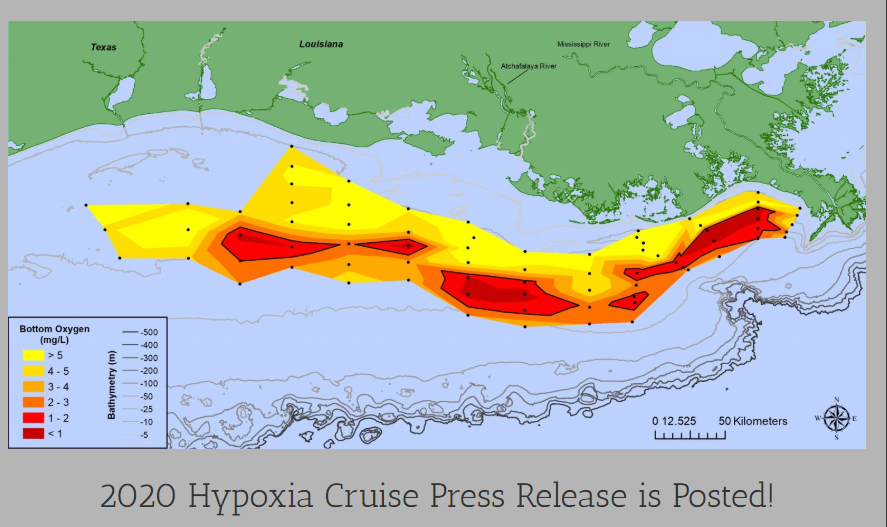|
This post is from the Mississippi River Network blog: https://1mississippi.org/2020-noaa-dead-zone-prediction-and-how-it-affects-your-community/ By Kristen Mertz, 1 Mississippi Outreach Coordinator  Every year in late July, NOAA scientists sample waters in the Gulf to predict the extent of the hypoxic area known as the Dead Zone. 2020's data is in! (Map from gulfhypoxia.net.) Every year in late July, NOAA scientists sample waters in the Gulf to predict the extent of the hypoxic area known as the Dead Zone. 2020's data is in! (Map from gulfhypoxia.net.) Lingering at the base of the Mississippi River watershed, a staggeringly large hypoxic zone, known as the Gulf of Mexico’s ‘Dead Zone’, has begun suppressing aquatic life and livelihoods within coastal communities. The National Oceanic and Atmospheric Association (NOAA) is forecasting the 2020 Gulf of Mexico Dead Zone to be 6,700 square miles, which is larger than the long-term average of 5,387 square miles. Nicole LeBoeuf, acting director of NOAA’s National Ocean Service, stated, “not only does the dead zone hurt marine life, but it also harms commercial and recreational fisheries and the communities they support”. Hypoxic zones pose a significant threat to benthic invertebrates, such as shrimp, crab, mussels, and starfish, as they are less mobile than other aquatic species, such as pelagic fish or aquatic mammals, who can often migrate away from the depleted oxygen waters. During hypoxic spells, benthic invertebrates will begin to shift their behavior patterns by reducing their feeding, decline in reproduction, and can become widely throughout the ocean floor. If there is a decrease in communities of benthic invertebrates, it will lead to a decline of other marine species due to simple science, the lack of food in the web. “Not only have commercial/recreational fishing began to suffer, but tourism within coastal communities as well. Hotels, restaurants/bars, watercraft recreation, etc. are all feeling the brunt of the dead zone in the Gulf of Mexico” -Louisiana shrimp farmer, Thomas Olander A Louisiana shrimp farmer, Thomas Olander, has observed the decline of benthic populations firsthand. In an interview with Travis Lux from New Orleans Public Radio, Olander states, “we’re not catching no large shrimp; there’s no explaining this here other than it’s something’s wrong with our water.” Jumbo shrimp are the most highly sought and has the highest market prices. This proves an issue to not only benthic communities but the livelihood of commercial fishermen such as Olander. Thomas Olander also captured pictures on his phone for others to observe the toxic algal blooms lingering at the surface of the dead zone where he normally would fish. Martin Smith, an environmental economist at Duke University, states, “the stress of fleeing can stunt the growth of shrimp; the dead zone causes the average price of shrimp to drop – which means shrimpers like Olander make less money.” Not only have commercial/recreational fishing began to suffer, but tourism within coastal communities as well. Hotels, restaurants/bars, watercraft recreation, etc. are all feeling the brunt of the dead zone in the Gulf of Mexico, with the lack of tourists. The hypoxic waters can be toxic to humans and our pets, which is why it is advisable to avoid the algal blooms. (Click the READ MORE link below the picture for more info on hypoxia.) Stephanie Joyce, author of “The Dead Zones: Oxygen-Starved Coastal Waters” observes that hypoxic zones naturally occur throughout the world, in places such as the northern Adriatic Sea, the Baltic Sea, and the Black Sea, but the Gulf of Mexico has become a dead zone due to a decline in water quality, population increase, and coastal development. Joyce states, “scientists attribute the Gulf of Mexico hypoxic zone largely to nutrient runoff from agriculture in the enormous Mississippi basin, which releases 1.6 million metric tons of nitrogen annually”. “During the warm months, these nutrients fuel eutrophication, which causes excessive algal blooms that can degrade aquatic habitats by reducing light levels, destroying habitats (including fragile systems such as coral reefs), and harming marine life by producing toxins, some of which also harm humans” – Stephanie Joyce, Author Agriculture may be one culprit creating the dead zone, but it is certainly linked to other human activities happening within the watershed as well. Other forms of human activities include, but are not limited to: “land transformation, ground-water drainage, urban stormwater runoff, sewage treatment, or atmospheric emissions through fossil fuel burning and volatilization of agricultural waste.” By not adequately sustaining our activities as humans, we begin to see environmental disturbances, such as the dead zone. As we have discovered, a majority of the nitrogen and phosphorus, contributing to the toxic algal blooms and leading to hypoxia within the Gulf of Mexico, is sourcing from agricultural and urban runoff. Nitrogen and phosphorus are primarily found within chemical fertilizers, detergents, and human/animal waste (EPA). Simple actions, such as:
 – Kristen Mertz, 1 Mississippi IL/MO Outreach Coordinator
1 Comment
|
| LWV Upper Mississippi River Region | UMRR blog |

 RSS Feed
RSS Feed